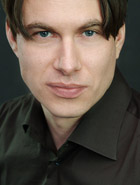 (Image: Method - Global Mental Model, Wolf H. Nöding)
(Image: Method - Global Mental Model, Wolf H. Nöding)Since the launch party of the new IA Institute website at this years IA Summit in Las Vegas 2007 I was asked quite often from people how the concept deliverables of the new website look like. Well, here we start with describing some main steps of development.
Note: I was told from people of the IAI Community that they used this Global Mental Model as a communication tool with their clients very successfully already. And a while ago I was asked by James Kalbach to write a brief method description of this Global Mental Model for his upcoming book where he mentions this method briefly which I developed during the conceptional phase for the IA Institute website.
The following is a short description of the method:
-----------------------------------------------------------------------------------------------------------
High level Mental Model
Short description of a Diagram that's part of the concept for the IA Institute website.
As one part of a concept for the IA Institute website the diagram shows an abstract(higher level) mental model. With it's molecular like appearance this model presents the main tasks of the website(arranged on middle circle) in it's Top Down and Bottom up stakeholder context.
The goal - create communication base
The general goal here was to deliver a complete(global) scenario with its strongest leverages, relations(active and passive) and POIs (Point of interests). Business goals and requirements as well as user requirements will be able to be discussed, based on this overall scenario.
Method - process of development
The input for the diagram results from surveys and interviews with IA members(US and Europe) and was first clustered in a mindmap. According to the given information the diagram is developed and growing iteratively based on all important relations (visualised as active/passive and less/strong demand arrows ). A variety of keys indicate relations like:
• one way/two way relations
• active/passive
• Top-Down, Bottom-Up
• strong Demand
• regular focus
• strong focus
• sub case
There is an active/passive relation between “Contribute” and “Find IA information” for example. This indicates that the contribution of documents is related to their findability and therefore can actively support the process.
The strong relation between Contribution and Collaboration indicates a higher amount of requirements which address the relation between them.
The complete diagram finally reflects the given input during the information gathering process e.g. interviews and surveys. In the continuing concept workflow the diagram is used as an information source to develop detailed use cases and wireframes. Until the final launch it’s also always useful to support the iteration steps including optimisations and fine tunings as a “consulting” document.
Consolidated findings
- Useful to receive an awareness over the complex relation scenario of the website
- The scenario is global and should therefore be complete.
- As an information visualisation it’s valuable for communication purposes between team participants.
- Using an abstract model like this it’s necessary that all concept team participants have a sense for abstract thinking. This might not always be the case.


1 Kommentar:
Kommentar veröffentlichen